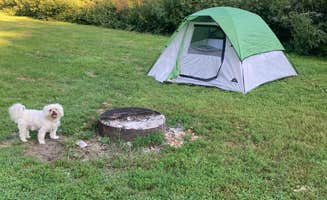Dispersed camping near De Soto, Wisconsin focuses on primitive wilderness experiences in the unique Driftless Area, a region characterized by deeply carved river valleys and forested ridges. Winter temperatures often drop below 0°F while summer highs regularly exceed 85°F with high humidity. The area's topography creates distinct microclimates with significantly cooler temperatures in shaded valleys compared to exposed ridgelines where campers find rustic sites.
What to do
Hiking with elevation challenges: The Richard J Dorer Memorial State Forest Reno Unit offers steep terrain with significant dropoffs that rewards adventurous hikers. "This is an awesome place to hike, not a very long hike but it's steep with drop offs. Not for those that are scared of heights," notes Michael V., who also mentions camping in "the old rock Cory" when staying at this rustic camping spot.
Biking to remote sites: Root River Canoe Campsite offers access via multiple transportation methods. According to one camper, "There is a bike trail that had a fork in the road that leads right to it someone could walk, hike, canoe or kayak to access this campground." The site features basic amenities including pit toilets, picnic tables, and fire rings, making it suitable for cyclists looking for overnight stops.
Water-based camping: Crater Island provides boat-in only camping opportunities on the Mississippi River. Accessible exclusively by watercraft, this area tends to attract social gatherings during peak season. The site lacks facilities but offers direct water access and sandy shorelines for camping.
What campers like
Secluded overlooks: The Isinours Management Unit features elevated camping spots with panoramic views. "There are a few spaces with views you can hike in to but I opted for a spot next to my car. And ideal spot for a one nighter," reports Demeri C. about this dispersed camping area, noting they "even walked the trails for a few miles before bed."
Social atmosphere: Crater Island draws boaters seeking community experiences on the water. "Big parties in the cove. No bathrooms no showers, just sand and water," explains Michael V. about this Mississippi River destination. He notes that alternative camping spots exist nearby: "If it is closed, there are plenty of islands and beaches near by to set up for camping."
Historical camping grounds: Root River Canoe Campsite preserves camping traditions dating back decades. One visitor explains, "This was used and built by Boy Scouts ages ago. It's still exist, however the river changed course and is further away than it once was." The site retains basic infrastructure despite its aging facilities and changing landscape.
What you should know
Access limitations: Many rustic camping areas near De Soto require significant effort to reach. At Isinours Management Unit, reaching the prime spots demands physical exertion. "The hike up the hill to the overlook is a daunting one. We used a collapsible wagon to haul all the supplies up the hill," reports Stephanie K.
Seasonal closures: Water-based camping options face restrictions during maintenance periods. Crater Island experiences periodic closures related to river management activities, with one camper noting it may be "closed... if there is dredging operations going on."
Limited site definition: Rustic camping areas often lack clear boundaries between sites. At the Richard J Dorer Memorial State Forest Reno Unit, "camp spots are not well marked," according to visitor reports, requiring campers to locate suitable areas independently.
Tips for camping with families
Bring hauling equipment: When accessing elevated sites with children, transportation tools prove essential. For the steep trails at Isinours Management Unit, one family recommends bringing "a collapsible wagon to haul all the supplies up the hill" to reach the scenic overlook campsites.
Consider height safety: Some locations present vertical challenges unsuitable for young children. The Richard J Dorer Memorial State Forest Reno Unit features terrain that's "not for those that are scared of heights," making it potentially problematic for families with small children or those uncomfortable with exposed elevations.
Look for alternatives during closures: Water-based camping requires backup plans during maintenance periods or high-traffic weekends. When primary locations like Crater Island are unavailable, campers should research "islands and beaches near by to set up for camping" as alternatives.
Tips from RVers
Focus on drive-in options: Most dispersed camping near De Soto suits tent camping exclusively, with few accommodating larger vehicles. Isinours Management Unit offers limited drive-up sites as alternatives to the hike-in overlook locations, with one camper noting they "opted for a spot next to my car" rather than the more remote options.
Pack light or bring transport assistance: For RVers willing to leave their vehicles behind, hauling gear becomes the primary challenge. Consider equipment like collapsible wagons, backpacks, or multiple trips when transitioning from vehicle to remote camping locations.
Prepare for primitive conditions: Even drive-in rustic sites lack typical RV amenities like hookups or dump stations. Campers should arrive self-contained with sufficient water, waste storage capacity, and power solutions for their stay.


